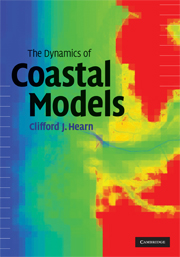Book contents
- Frontmatter
- Contents
- Preface
- Acknowledgements
- Note on mathematics and model codes
- 1 Prelude to modeling coastal basins
- 2 Currents and continuity
- 3 Box and one-dimensional models
- 4 Basic hydrodynamics
- 5 Simple hydrodynamic models
- 6 Modeling tides and long waves in coastal basins
- 7 Mixing in coastal basins
- 8 Advection of momentum
- 9 Aspects of stratification
- 10 Dynamics of partially mixed basins
- 11 Roughness in coastal basins
- 12 Wave and sediment dynamics
- References
- Index
- References
1 - Prelude to modeling coastal basins
Published online by Cambridge University Press: 18 December 2009
- Frontmatter
- Contents
- Preface
- Acknowledgements
- Note on mathematics and model codes
- 1 Prelude to modeling coastal basins
- 2 Currents and continuity
- 3 Box and one-dimensional models
- 4 Basic hydrodynamics
- 5 Simple hydrodynamic models
- 6 Modeling tides and long waves in coastal basins
- 7 Mixing in coastal basins
- 8 Advection of momentum
- 9 Aspects of stratification
- 10 Dynamics of partially mixed basins
- 11 Roughness in coastal basins
- 12 Wave and sediment dynamics
- References
- Index
- References
Summary
Coastal basins
This book explains the basic dynamics of bays, estuaries, and lagoons through the use of simple models. There is a focus on physically simple systems for which easy-to-understand models give good insight into basic processes. These models may be either analytical or numerical (or ideally both). The book uses these simple models to present our basic ideas of processes in coastal basins with a deliberate emphasis on box models and simple one-dimensional and (occasionally) higher-dimensional models. The book avoids, as far as possible, the complexities of three-dimensional models in favor of the simplicity of lower-dimensional models.
I use the term coastal basins to represent the myriad of different water bodies which we find in the region between the land and the open continental shelf. They carry local names such as estuary, bay, sound, inlet, gulf although those names are also used for systems which lie on the continental shelf or form a part of deep ocean basins. Finding a generally accepted name is not easy and the obvious choice of estuaries is not really correct in so far as estuaries normally have a very dominant circulation due to density differences; whereas much of the basic dynamics of many coastal basins is due to tides, winds, and waves. The term lagoon is also a possibility but carries a connotation of certain types of morphology.
- Type
- Chapter
- Information
- The Dynamics of Coastal Models , pp. 1 - 31Publisher: Cambridge University PressPrint publication year: 2008



